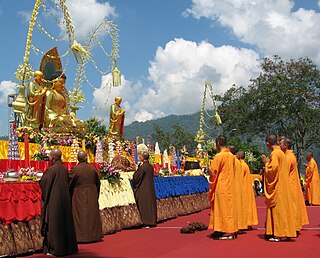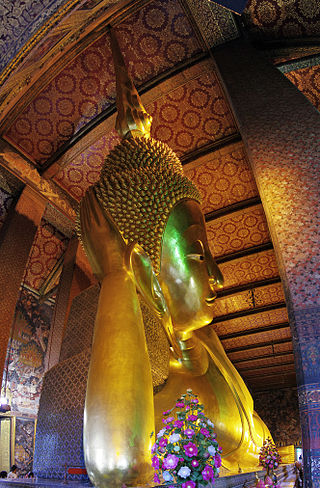
Vesak, also known as Buddha Jayanti, Buddha Purnima, Buddha Day, and Phật Đản, is a holiday traditionally observed by Buddhists in South Asia and Southeast Asia, as well as Tibet and Mongolia. It is the most important Buddhist festival. The festival commemorates the birth, enlightenment (Nibbāna), and passing (Parinirvāna) of Gautama Buddha in Theravada, Tibetan Buddhism and Navayana.
The Mon are an ethnic group who inhabit Lower Myanmar's Mon State, Kayin State, Kayah State, Tanintharyi Region, Bago Region, the Irrawaddy Delta, and several areas in Thailand. The native language is Mon, which belongs to the Monic branch of the Austroasiatic language family and shares a common origin with the Nyah Kur language, which is spoken by the people of the same name that live in Northeastern Thailand. A number of languages in Mainland Southeast Asia are influenced by the Mon language, which is also in turn influenced by those languages.

Phra Phutthayotfa Chulalok Maharaj, personal name Thongduang (ทองด้วง), also known as Rama I, was the founder of the Rattanakosin Kingdom and the first monarch of the reigning Chakri dynasty of Siam. His full title in Thai is Phra Bat Somdet Phra Paramoruracha Mahachakkriborommanat Phra Phutthayotfa Chulalok. He ascended the throne in 1782, following the deposition of King Taksin of Thonburi. He was also celebrated as the founder of Rattanakosin as the new capital of the reunited kingdom.

Chiang Rai is the northernmost major city in Thailand, with a population of about 200,000 people. It is located in Mueang Chiang Rai District, Chiang Rai Province. Chiang Rai was established as a capital city in the reign of King Mangrai, in 1262 CE.

Bodh Gayā is a religious site and place of pilgrimage associated with the Mahabodhi Temple Complex in Gaya district in the Indian state of Bihar. It is famous as it is the place where Gautama Buddha is said to have attained Enlightenment under what became known as the Bodhi Tree. Since antiquity, Bodh Gaya has remained the object of pilgrimage and veneration both for Hindus and Buddhists. In particular, archaeological finds including sculptures show that the site was in use by Buddhists since the Mauryan period.

Shakya was an ancient eastern sub-Himalayan ethnicity and clan of north-eastern region of the Indian subcontinent, whose existence is attested during the Iron Age. The Shakyas were organised into a gaṇasaṅgha, also known as the Shakya Republic. The Shakyas were on the periphery, both geographically and culturally, of the eastern Gangetic plain in the Greater Magadha cultural region.

Mandalay is the second-largest city in Myanmar, after Yangon. Located on the east bank of the Irrawaddy River, 631 km north of Yangon, the city has a population of 1,225,553.

The Karen, also known as the Kayin, Kariang or Kawthoolese, are an ethnolinguistic group of Sino-Tibetan language-speaking peoples. The group as a whole is heterogeneous and disparate as many Karen ethnic groups do not associate or identify with each other culturally or linguistically. These Karen groups reside primarily in Kayin State, southern and southeastern Myanmar. The Karen, approximately five million people, account for approximately seven percent of the Burmese population. Many Karen have migrated to Thailand, having settled mostly on the Myanmar–Thailand border. A few Karen have settled in the Andaman and Nicobar Islands, India, and other Southeast Asian and East Asian countries.

Wat Pho, also spelled Wat Po, is a Buddhist temple complex in the Phra Nakhon District, Bangkok, Thailand. It is on Rattanakosin Island, directly south of the Grand Palace. Known also as the Temple of the Reclining Buddha, its official name is Wat Phra Chetuphon Wimon Mangkhalaram Rajwaramahawihan. The more commonly known name, Wat Pho, is a contraction of its older name, Wat Photaram.

The Marma, also known as Moghs, Mogs or Maghs, are the second-largest ethnic community in Bangladesh's Chittagong Hill Tracts, primarily residing in the Bandarban, Khagrachari and Rangamati Hill Districts. Some Marmas live in Bangladesh's coastal districts of Cox's Bazar and Patuakhali, while others live in Tripura, India and Myanmar. There are about 324,261 Marmas living in Bangladesh and 35,722 of them living in India. Since the 16th century, the Marma have considered the Bengal's Chittagong Hill Tracts their home, where they have established the Bohmong and Mong Circles (chiefdoms).

Maudgalyāyana, also known as Mahāmaudgalyāyana or by his birth name Kolita, was one of the Buddha's closest disciples. Described as a contemporary of disciples such as Subhuti, Śāriputra, and Mahākāśyapa, he is considered the second of the Buddha's two foremost male disciples, together with Śāriputra. Traditional accounts relate that Maudgalyāyana and Śāriputra become spiritual wanderers in their youth. After having searched for spiritual truth for a while, they come into contact with the Buddhist teaching through verses that have become widely known in the Buddhist world. Eventually they meet the Buddha himself and ordain as monks under him. Maudgalyāyana attains enlightenment shortly after that.

The Kuki people are an ethnic group in the Northeastern Indian states of Manipur, Nagaland, Assam, Meghalaya, Tripura and Mizoram, as well as neighbouring countries of Bangladesh and Myanmar. The Kuki constitute one of several hill tribes within India, Bangladesh, and Myanmar. In Northeast India, they are present in all states except Arunachal Pradesh.

Buddhist art is visual art produced in the context of Buddhism. It includes depictions of Gautama Buddha and other Buddhas and bodhisattvas, notable Buddhist figures both historical and mythical, narrative scenes from their lives, mandalas, and physical objects associated with Buddhist practice, such as vajras, bells, stupas and Buddhist temple architecture. Buddhist art originated in the north of the Indian subcontinent, in modern India, Pakistan and Afghanistan, with the earliest survivals dating from a few centuries after the historical life of Siddhartha Gautama from the 6th to 5th century BCE.
Many adherents of Buddhism have experienced religious persecution because of their adherence to the Buddhist practice, including unwarranted arrests, imprisonment, beating, torture, and/or execution. The term also may be used in reference to the confiscation or destruction of property, temples, monasteries, centers of learning, meditation centers, historical sites, or the incitement of hatred towards Buddhists.

Myawaddy is a township in southeastern Myanmar, in Kayin State, close to the border with Thailand. Separated from the Thai border town of Mae Sot by the Moei River, the town is the most important trading point between Myanmar and Thailand. Myawaddy is 170 kilometres (110 mi) east of Mawlamyine, the fourth largest city of Myanmar, and 426 kilometres (265 mi) northwest of Bangkok, the capital of Thailand.

The relics of Sariputta and Moggallana refers to the cremated remains of the Buddhist disciples Sariputta and Moggallana. Sariputta and Moggallana were the two chief disciples of the Buddha, often stylized as the right hand and left hand disciples of the Buddha respectively. The two disciples were childhood friends who ordained under the Buddha together and are said to have become enlightened as arahants. The Buddha declared them his two chief disciples, after which they assumed leadership roles in the Buddha's ministry. Both of the chief disciples died a few months before the Buddha near the ancient Indian city of Rājagaha in what is now Bihar, and were cremated. According to Buddhist texts, the cremated remains of the disciples were then enshrined in stupas at notable monasteries of the time, with Sariputta's remains being enshrined at Jetavana monastery and Moggallana's remains being enshrined at Veḷuvana monastery. However, as of 1999 no modern archaeological reports have confirmed this, although in 1851 discoveries were made at other sites.

The Golden Buddha, officially titled Phra Phuttha Maha Suwanna Patimakon, commonly known in Thai as Phra Sukhothai Traimit, is a gold Maravijaya Attitude seated Buddharupa statue, with a weight of 5.5 tonnes. It is located in the temple of Wat Traimit, Bangkok, Thailand. At one point in its history, the statue was covered with a layer of stucco and coloured glass to conceal its true value, and it remained in this condition for almost 200 years, ending up as what was then a pagoda of minor significance. During relocation of the statue in 1955, the plaster was chipped off and the gold revealed.

James (Jack) Daulton is an American art collector, trial lawyer, music entrepreneur, exploration philanthropist, and expert and lecturer on the history of art and architecture. Daulton rose to fame representing the nation of Myanmar in the groundbreaking 1994 legal case, United States v. Richard Diran and The Union of Myanmar, successfully recovering a 1,000-year-old Buddha statue that had been stolen in 1988 from a temple in Myanmar's ancient capital, Bagan, a treasure now on display in the National Museum in Yangon. This was the first cultural property claim litigated by a Southeast Asian nation in the United States. Daulton has also gained recognition as a result of The Daulton Collection–his vast art collection which includes one of the world's largest private collections of German Symbolist art and, in particular, the world's largest collection of works by a number of individual artists, such as the eccentric monkey painter Gabriel von Max, the Austrian symbolist Rudolf Jettmar, and the proto-hippie Fidus. Among The Daulton Collection's highlights are masterpieces of symbolist portraiture, including Karl Gussow's Portrait of the Novelist Ossip Schubin (1887), Rudolf Jettmar's Self-Portrait of the Young Artist (1896), and Oskar Zwintscher's The Woman in Hamster (1914), currently on long-term loan to the Albertinum, Staatliche Kunstsammlungen, in Dresden. In 2021, a painting from The Daulton Collection, Gabriel von Max's Abelard and Heloise, was the "face" of the major exhibition at the Musée d'Orsay, Paris, "Les Origines du Monde: L'invention de la nature au XIXe siècle". In addition, Daulton is well known as an expert on non-western art, architecture, and religion, acclaimed for his many lectures on those subjects for institutions such as National Geographic, The American Museum of Natural History, and The Art Institute of Chicago. He is also well known for his activity in exploration philanthropy, funding research expeditions around the globe, from archaeological digs in the Peruvian Andes to language documentation projects on remote atolls in Micronesia. And as an art and entertainment lawyer in the 1990s, Daulton developed the major-label rock band Kill Hannah, among other recording artists.

Art of Myanmar refers to visual art created in Myanmar (Burma). Ancient Burmese art was influenced by India and was often religious in nature, ranging from Hindu sculptures in the Thaton Kingdom to Theravada Buddhist images in the Sri Ksetra Kingdom. The Bagan period saw significant developments in many art forms from wall paintings and sculptures to stucco and wood carving. After a dearth of surviving art between the 14th and 16th century, artists created paintings and sculptures that reflect the Burmese culture. Burmese artists have been subjected to government interference and censorship, hindering the development of art in Myanmar. Burmese art reflects the central Buddhist elements including the mudra, Jataka tales, the pagoda, and Bodhisattva.

Wat Hong Rattanaram Ratchaworawihan, or just called Wat Hong Rattanaram is an ancient Thai Buddhist temple located in Bangkok rim the Khlong Bangkok Yai canal. It is classified as the second rank of royal temple and can be considered a temple of Prince Pinklao.


















